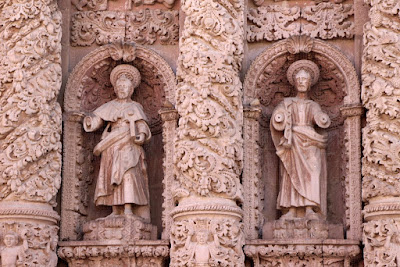Our trip from Aguascalientes to Manzanillo took us through
some of the most beautiful country anywhere.
We crossed broad plains surrounded by mountains. We were in Mexico’s agricultural region. We passed fields of agave from which tequila
is made. The plants take 10-12 years to
reach the stage when their juices can be extracted and fermented.
We saw horse and cattle ranches and hay
fields to support them. Large tracts of
hot houses covered acres and acres of ground.
There was sugar cane, mango groves and coconut groves. All of the produce from these and many other
crops was sold at roadside fruit stands.
The road from Guadalajara passed over a perfectly flat dry lakebed that
stretches for miles. What? Was that a hippopotamus?
The lake bed eventually gave way to the surrounding
mountains. As we approached Colima, twin
volcanic peaks dominated the horizon for miles.
One of the volcanoes has long been dormant. You can see smoke rising from the other which
last erupted in 2015.
Kathleen’s brother Steve does not actually live in
Manzanillo. His house is located in
nearby tiny El Naranjo.
A dirt road
leads up a steep hill to his house. From
his house, you look out past a mango tree loaded with mangoes, bougainvillea, other
flowers and banana plants. A yucca tree
yields a delicious, huge fruit the size of a basketball. No wonder he likes it here! He has a menagerie that includes chickens
(that haven’t learned to sleep until 10AM), rabbits, ducks, turtles and a
nameless dog that we dubbed “Happy” because he was always smiling. There were also uninvited members of the zoo.
Manzanillo is a large city and a major port. It is also the location of several resorts.
Mexicans love their coast.
The beaches are crowded every week-end.
Waterfront restaurants line the beaches.
Vendors with pushcarts sell everything from ice cream and juices to
fresh fruit. I enjoyed some of the best
oysters I’ve ever had.
I do need to say
that even though I miss conch salad in the Bahamas I hardly noticed its
absence. You can get some of the best
ceviche anywhere in Mexico. On the
coast’ it is absolutely fresh. If you
are ever in Manzanillo, you must try the ceviche at Mariscos al aliviane. This is a tiny, streetside place with one
tiny table. They make a great ceviche
with fish, scallops, shrimp and octopus.
It’s located across the street from the Hotel Playa de Santiago.
We were lucky enough to be in Mexico during Semana Santa
(Holy Week). Mexicans celebrate this in
a big way. It’s bigger than Christmas at
home. Maybe a lot like Mardi Gras in New
Orleans. The whole week is an excuse to
party. People flock to the beaches and
other places of interest. Whole empty
fields turn into huge parking lots and temporary carnes asadas stands.
We drove to Comala near Colima on Palm Sunday. Comala is a small community of whitewashed
houses, cobblestone streets and a beautiful cathedral. The inhabitants call it the “Magic Pueblo.” A big fair filled the square in front of the
church.
Nearby is the “Zona Magica.”
People come from all over to experience a unique phenomenon. There is a stretch of road where it clearly
looks like you are going downhill. Yet,
when you put the car in neutral, it rolls uphill! Put a cylindrical object on the road and it
to rolls uphill. Pour water on the
pavement and it flows uphill. Plumbers
beware!
We enjoyed a fine meal at a “bontanero.” This was a humongous place. There must have been at least 1000 people
there.
It’s a great place for families
and big parties. You pay for a bucket of
beer, 8-10 bottles. They start bringing
out the food—a succession of tostadas, tortillas, quesadillas, tacos, all
covered or stuffed with all kinds of savory meats, fish, shrimp, ceviche,
avocadoes and pico de gallo. The food
keeps coming until you tell them to stop.
All the while, you are surrounded by merrymaking, mariachis, and
laughter. All this for the price of a
few beers and soft drinks! We were
accompanied by Steve, his friend Liliana, her son and daughter, her friend
Claudia and her son. There were 8 of
us. The meal totaled the equivalent of
$60.00 US, that included the tip. We had a great time!.
One other thing, even though we aren't in the Bahamas this winter, we can still enjoy them! And, like the Bahamians, Mexicans have a great sense of humor.




















































